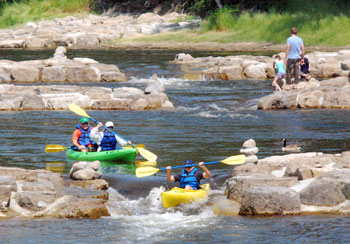“Argo Cascades” at the dam. [photo]
Stories indexed with the term ‘Argo Cascades’
Rotary to Fund Universal Access Playground
Ann Arbor park advisory commission meeting (Jan. 28, 2014): Park commissioners got news at their most recent meeting that the Rotary Club of Ann Arbor is making a $250,000 contribution to the city of Ann Arbor for a major new “universal access” playground at Gallup Park, to celebrate the club’s centennial anniversary in 2016.
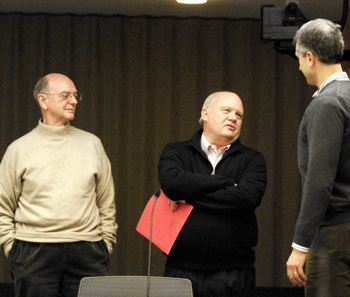
From left: Bernie Lugauer and Bob Buckler of the Rotary Club of Ann Arbor talk with Christopher Taylor, an ex officio member of the Ann Arbor park advisory commission. (Photos by the writer.)
After a presentation on Jan. 28, commissioners recommended that the city apply for a state Dept. of Natural Resources grant to help fund the remainder of the work, which is estimated to cost $500,000.
Colin Smith, the city’s parks and recreation manager, told commissioners that although there are about 80 playgrounds in Ann Arbor, none are universally accessible. It’s a “huge shortcoming” for the parks system, he said. The exact location within Gallup Park hasn’t been determined, but the playground would be about 5,000 square feet and exceed the requirements of the Americans with Disabilities Act (ADA). The design and equipment is intended to create environments that can be used by all people, with features like ramps, color-contrasting structures, wider bridges and walkways, and playground equipment that makes it easier for people using wheelchairs.
Two Rotary representatives attended the Jan. 28 meeting to help describe the club’s role in the project. Bob Buckler, a Rotary director and co-chair of the group’s centennial committee, told commissioners that in general the Rotary’s primary focus is on supporting children, by funding scholarships, Washtenaw Success By Six and other programs. That’s why the universal access playground is so appealing as a way to celebrate Rotary’s centennial, he said. Buckler indicated that fundraising for this project has already begun. The grand opening is expected to be on Labor Day in 2016.
In other action on Jan. 28, commissioners approved the location for new tennis courts at Windemere Park – a project that’s been in the works for about two years. The location has been somewhat controversial among neighbors, and prompted a review of the previously selected site. The current courts have deteriorated and are in a location where it’s unsuitable to rebuild.
Also on Jan. 28, PAC recommended the purchase of two vans to keep up with the increasing shuttle transportation demands for Huron River trips in 2013, following the opening of Argo Cascades.
The meeting marked a transition of members on PAC. It was the first meeting for David Santacroce, who was appointed by the city council last year to replace Julie Grand. And it was the final meeting for Jen Geer, who has resigned after less than a year on the commission. Paige Morrison was appointed by the council on Feb. 3 to fill the remainder of Geer’s term – through May 19, 2016. [Full Story]
Parks Group Recommends Van Purchase
At their Jan. 28, 2014 meeting, Ann Arbor park advisory commissioners recommended purchasing two 15-seat GMC Savana passenger vans from Red Holman GMC in Oakland County for a total of $50,212.
According to a parks staff memo, the city’s current fleet of seven 15-passenger vans was unable to keep up with the increasing shuttle transportation demands for Huron River trips in 2013, following the opening of Argo Cascades. More vans are needed to transport people on these trips, which start at the Argo livery and end at Gallup Park. One van in the fleet needs to be replaced. The other van purchase would increase the total van fleet to eight.
The new vans will be purchased out of the FY 2014 parks & recreation … [Full Story]
Public Art Commission Plans for Future
Ann Arbor public art commission meeting (Oct. 23, 2013): The most recent AAPAC meeting focused on an ongoing transition for Ann Arbor’s public art program.
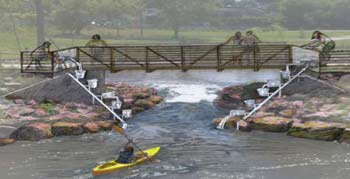
Rendering of “Bucket Cascade” proposal by Mags Harries and Lajos Heder. It’s one of two finalists for public art at the city’s Argo Cascades.
Commissioners were briefed about the city’s capital improvements plan (CIP), which will now be integral to the public art program. AAPAC and city staff will identify projects in the CIP that might be candidates for public art “enhancements” – if the council agrees and provides additional funding for that purpose. It’s a change from the previous Percent for Art program, which the city council eliminated earlier this year.
Deb Gosselin, who oversees the CIP process, attended AAPAC’s meeting and described a decision-making matrix that’s used to help city staff prioritize capital projects. AAPAC plans to use that matrix as a model for developing its own method of prioritizing potential public art projects.
Commissioners also briefly discussed four possible capital projects that might include public art enhancements, including an enclosure of the farmers market, and a retaining wall to be built as part of a Stadium Boulevard reconstruction.
Some of these issues will likely be picked up during a retreat that’s set for Nov. 20. The idea of a retreat was proposed by one of the newer commissioners, Ashlee Arder, as a way to get to know each other better, as well as to discuss the creation of AAPAC’s annual plan, which is due to the council in early 2014. Arder also hopes to assemble a “curated team” from different sectors of the community, to help AAPAC develop ideas for fostering public art as well as the broader creative sector.
Also at their most recent meeting, commissioners acted on a specific project that’s already underway. They authorized applying for a $40,000 grant from the Community Foundation of Southeast Michigan to fund a public art project in the Arbor Oaks/Bryant neighborhood on Ann Arbor’s southeast side. But they tabled another proposal – for artwork at the roundabout on South State and Ellsworth – until their February 2014 meeting, allowing time for commissioners to see how it might fit into an overall public art plan.
Updates were provided during the meeting on several other projects, including the Coleman Jewett memorial at the farmers market, finalists for artwork at Argo Cascades, and a plan to add an artistic element to the city’s new bike share program. [Full Story]
Argo Cascades
Paddler playing in the last drop of the run. [photo]
Design Approved for Rain Garden Sculptures
Ann Arbor public art commission meeting (Aug. 28, 2013): The only major action item for public art commissioners was approval of Joshua Wiener’s design for artwork in a new rain garden at the southeast corner of First & Kingsley.

A drawing of Joshua Wiener’s proposed rain garden sculptures at First & Kingsley. (Image provided in the AAPAC Aug. 28, 2013 meeting packet.)
His proposal entails creating white metal images of five small mouth bass, in varying sizes, that appear to be emerging from the landscape and pointed toward the Huron River. Two of the sculptures will be large enough to serve as benches.
Because the artist’s contract of $23,380 is less than $25,000, it does not require city council approval. The sculptures would likely be installed during the spring of 2014.
Commissioners also received several updates during the meeting, and reviewed a new spreadsheet designed to track more effectively current and potential projects. [.xls file project tracker] Aaron Seagraves, the city’s public art administrator, reported that a selection panel picked Catherine Widgery of Cambridge, Mass., as the artist for a major public art project on the East Stadium bridges in Ann Arbor. However, the panel is asking Widgery to revise her proposal before presenting it to AAPAC and the city council for approval. The project has a $400,000 total budget.
Other updates covered projects at Argo Cascades, the city’s wastewater treatment plant, Arbor Oaks Park, a memorial for Coleman Jewett at the Ann Arbor Farmers Market, and the “Canoe Imagine Art” community project. Additional potential projects were mentioned, including possible artwork for the new bike share program and the public skatepark, which is now under construction at Veterans Memorial Park.
Commissioners also viewed a short video produced by Ashlee Arder, one of the newest members of AAPAC. The intent is to promote the commission and the city’s public art program. The video is already available on YouTube, and Arder plans to post it on the commission’s website, Facebook page and Twitter account, @AAPublicArt.
The meeting was attended by six of the seven commissioners, including Marsha Chamberlin, who participated via conference call. There are two vacancies on the nine-member commission. At the city council’s Aug. 19, 2013 meeting, Devon Akmon was nominated to fill one of the vacancies. Akmon is an Ann Arbor resident and the new director of the Arab American National Museum in Dearborn. At its Sept. 3 meeting, the city council is expected to vote on Akmon’s confirmation to AAPAC .
No name has been put forward publicly for the second vacancy. One of the two vacancies resulted when Tony Derezinski was not reappointed. The other stemmed from Wiltrud Simbuerger’s resignation earlier this year. Her term would have ended Dec. 31, 2013. [Full Story]
Deliberations on DDA Pave Way for Final Vote
Ann Arbor city council meeting (April 1, 2013): The council’s first meeting in April featured some progress on items that have appeared repeatedly on its agenda in the last several weeks.
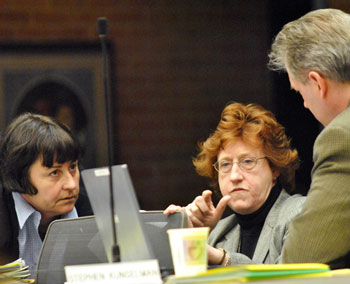
From left: Jane Lumm (Ward 2), assistant city attorney Mary Fales and Stephen Kunselman (Ward 3). (Photos by the writer.)
After two postponements, the council gave initial approval to a set of changes to the ordinance that establishes the Ann Arbor Downtown Development Authority (DDA). The changes can be divided into those that affect board composition and those that relate to the computation of the DDA’s tax increment finance (TIF) capture.
The tax calculations have implications of roughly $1 million a year for the DDA and the taxing jurisdictions whose taxes are captured by the DDA. Those taxing jurisdictions include the city of Ann Arbor, Washtenaw County, Washtenaw Community College and the Ann Arbor District Library. The vote was 7-3, as mayor John Hieftje, Margie Teall (Ward 4) and Chuck Warpehoski (Ward 5) voted no. Christopher Taylor (Ward 3) was absent. The final vote will likely come at the council’s April 15 meeting. Councilmembers are not obligated to vote the same way the second time around.
The council also wrapped up an issue that has appeared on its agenda for several meetings. At its March 18 meeting, the council had finally decided not to enact a moratorium on site plan applications in D1 (downtown core) zoning districts. Instead, the council had directed the planning commission to conduct a review of D1 zoning. But councilmembers had left open the question of the exact scope of work and the timeframe for its completion by planning commissioners. At the April 1 meeting, the council allowed the commission six months, until Oct. 1, to review the following: the appropriateness of D1 zoning on the north side of Huron Street between Division and South State and the south side of William Street between South Main and Fourth Avenue; the residential premiums; the zoning for the University of Michigan Credit Union parking lot.
Other business was further delayed by the council. At the developer’s request, the council postponed for a second time the 413 E. Huron project, a proposed 14-story, 216-apartment building at the northeast corner of Huron and Division streets. That project will come back before the council at its April 15 meeting. A new public hearing on the 413 E. Huron site plan application was started on April 1 and will continue on April 15.
The council also postponed a second and final vote on changes to the city’s sign ordinance. The changes would prohibit any new billboards, and allow only a limited range of digital signs. That won’t come back before the council until May 6. Several people addressed the council during the public hearing. All of them worked for Adams Outdoor Advertising, and spoke in opposition to the changes. Because of the postponement, the council extended a moratorium on digital sign applications, which has now been in place for a year.
The council also extended a moratorium on spending of monies that have been set aside under the city’s Percent for Art ordinance. A revision to that ordinance, which would likely eliminate the public art set-aside but still allow for aesthetic elements to be built into a project, is expected to be brought forward in the next few weeks. The public art ordinance revisions are being crafted by a council committee that was tasked with that responsibility in December of 2012.
At its April 1 meeting, the council also approved contracts for renovations at the Gallup Park canoe livery, and the Argo and Geddes dams. In addition, the council approved a lease for additional parking in connection with the Argo Cascades.
Other business at the meeting included council approval of the notice to issue bonds for the city’s drinking water system. The council also authorized contracts in connection with street reconstruction and sidewalk repair work for the 2013 season. [Full Story]
Parks Agenda: Downtown, Dogs, Dams, DTE
Ann Arbor park advisory commission meeting (March 19, 2013): A packed agenda for this month’s PAC meeting included several items related to downtown parks and the Huron River.
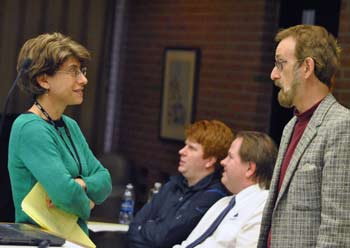
Park planner Amy Kuras, left, talks with Stewart Gordon, an advocate for putting an ice-skating rink atop the Library Lane site. In the background are Andrew Walton, left, and Doug Kelly, the city’s director of golf. Walton supervises the Huron Hills golf course. (Photos by the writer.)
Commissioners discussed a proposal to build an ice-skating rink atop a portion of the city-owned Library Lane underground parking structure. They took no action on the item, but were briefed on the proposal by two advocates of the effort: Alan Haber and Stewart Gordon. The two men also attended a subsequent March 26 meeting of a PAC downtown park subcommittee. This report includes a summary of that session as well.
River-related items on PAC’s March 19 agenda included a resolution to recommend awarding a $295,530 contract to Gerace Construction Co. for repair work and repainting at Argo and Geddes dams, as well as site improvements around Argo Dam. Brian Steglitz, an engineer with the city, told commissioners that the work is being done in response to the most recent inspection by state regulators.
Commissioners also recommended awarding a $512,180 contract for improvements at the Gallup Park canoe livery to Construction Solutions Inc., which will be funded in part by a $300,000 state grant. Cheryl Saam, facility supervisor for the Argo and Gallup canoe liveries, gave commissioners a presentation on those operations, in preparation for budget recommendations that PAC is expected to consider at its April 16 meeting.
As part of her report, Saam noted that the city plans to issue another request for proposals (RFP) to design a whitewater section along the Huron River, downstream from the Argo Dam near the Argo Cascades. Parks and recreation manager Colin Smith reminded commissioners that the first attempt at this project wasn’t successful. The Michigan Dept. of Environmental Quality did not approve the initial design, and would not issue the necessary permit for the project. The staff is working with the state to address MDEQ’s concerns, he said. Smith also reported that DTE Energy still intends to pay for the project, which is located adjacent to property that the utility company is cleaning up.
DTE representatives were on hand at the meeting because of a different project: To request an easement on city-owned land in Riverside Park, where utility poles are located. The easement is needed as part of an $8 million new electrical substation that DTE is building on land adjacent to the park. Commissioners unanimously recommended that the city council approve the easement.
In another presentation to set the stage for next month’s budget discussion, PAC heard from Doug Kelly, the city’s director of golf, and Andrew Walton, recreational facility supervisor at Huron Hills. They reviewed the status of the city’s two golf courses – at Huron Hills and Leslie Park – and noted that both courses have seen significant revenue gains over the past five years.
The issue that drew the most public commentary during the meeting wasn’t on the March 19 agenda: a possible dog park on a knoll in West Park. Residents in that area aren’t happy about the prospect of barking dogs in their neighborhood. [Full Story]
Longshore Parking for Argo OK’d
A $3,000 lease to accommodate overflow parking for the Argo canoe livery has been approved by the Ann Arbor city council. The vote came at the council’s April 1, 2013 meeting, having been pulled from the council’s March 18, 2013 consent agenda and postponed at that time.
Sabra Briere (Ward 1) had asked that the item be separated out from the consent agenda. Briere had heard concerns that the lot is not very well-graded and that there’s a lot of runoff. She wondered if there was a way for the city to enforce maintenance of the lot through the lease.
At the council’s April 1 meeting, Briere indicated that it was not feasible to enforce through the contract the kind of improvements … [Full Story]
Argo Cascades
Puzzling fencing draped from the bridge at the end of the cascades. Is someone trying to stop passage from there to the river? It would be easy to pass under, since it doesn’t go to the water line. [photo]
Argo Cascades
Bald eagle in tree. One, two, three, four crows gather: cawing, swooping, crowding. Eagle, still for minutes, spreads wings, takes off, pursued by the crows.
EPA, Others Object to Whitewater Project
Four entities – including the federal Environmental Protection Agency and the local Huron River Watershed Council – have filed letters of objection with the state of Michigan to a project that would add a recreational section of whitewater along the Huron River, next to the new Argo Cascades.

A view looking upstream at the Huron River from the Broadway Bridge, toward the section of the proposed whitewater feature. On the left is environmental remediation work on the DTE/MichCon property. (Photo by D. Askins.)
Colin Smith, Ann Arbor’s parks and recreation manager, informed the park advisory commissioners about the opposition at PAC’s Sept. 18, 2012 meeting, describing the news as “not especially positive.” Other letters filed against the project were from the state Dept. of Natural Resources fisheries division and the U.S. Fish & Wildlife Service.
The project requires a permit from the Michigan Dept. of Environmental Quality (MDEQ) because it affects the Huron River, a state waterway. The project was originally approved by the Ann Arbor city council in 2010, as part of a larger effort that included building the Argo Dam bypass, which wrapped up earlier this year. Subsequent to that council approval, DTE Energy offered to pay for and oversee the whitewater aspect, to coordinate it with environmental remediation work that’s taking place on property it owns along that stretch of the river, just downstream of Argo Dam.
DTE is the applicant for the whitewater permit, although the company is working closely with the city on the project. The city is interested in acquiring the DTE property along the Huron after remediation is completed – and it’s hoped that the company might gift it to the city as a park.
Smith told PAC members that the EPA objection – because it comes from a federal environmental oversight agency – has triggered a process that might stop the project. The EPA filed its letter on Aug. 15. From that date, the MDEQ has 90 days [until Nov. 13] to resolve the EPA’s concerns with the applicant.
The EPA’s letter from Tinka Hyde, director of the agency’s water division, states that the project could significantly degrade the Huron River by inhibiting fish passage and increasing the water velocity, which in turn could affect sediment flow and degrade the stability of that section of the river. Another concern cited is that the project could constrain public use of the river. Because of these issues, the EPA believes the project does not comply with the federal Clean Water Act. [.pdf of EPA letter]
Similar concerns were cited in the other letters of objection. Additional issues raised include water quality concerns that could affect the health of those using the whitewater area, who might come in contact with E.coli in the river; and exacerbated flow problems during drought periods. [U.S. Fish & Wildlife Services letter] [DNR fisheries division letter and additional attachments] [HRWC letter]
The DNR fisheries letter – signed by Jeffery Braunscheidel, senior fisheries biologist – also alludes to the contentious “dam in/dam out” debate involving Argo Dam. Structures used to create the whitewater are in essence dams, he stated, and the division does not support new dam construction. “Planning should provide for a naturally functioning system below Argo Dam as history has made clear that, at some point in time, the Argo Dam will be modified or removed. Impediments should not be constructed in the river that the public will again be asked to address.”
But it’s the EPA’s objection that carries the most weight. If the EPA does not withdraw its objection and the MDEQ still decides to grant the permit, then DTE would also need to seek a permit from the U.S. Army Corps of Engineers before the project can move forward. [Full Story]
How Low Can Argo Flow Go?
The full flow to the Argo Cascades was restored on Thursday, Aug. 2, 2012, according to a city of Ann Arbor press release, and the city is again renting kayaks and inner tubes for the series of pools and drops that offer an alternative boatable channel around the Argo Dam. Dry conditions had led the city to reduce the flow to the cascades during the previous week, on July 26.
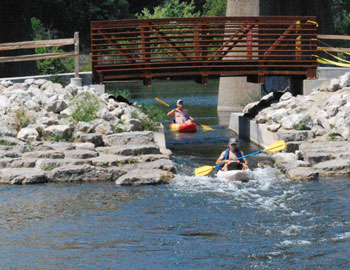
View looking north through the entrance to the Argo Cascades on Aug. 3, 2012. (Photos by the writer.)
Because the flow to the new recreational amenity was reduced, but not shut off completely last week, some confusion ensued about what measures, if any, the city had taken and why, and what the impact of those measures was.
At issue is the flow through two different channels – Argo Cascades on the one hand, and the stretch of the Huron River immediately below the Argo Dam on the other. The two channels are parallel and are separated by an earthen embankment, until they join together at a point just upstream of the Broadway bridge.
Downstream from that confluence, and near the Maiden Lane bridge, a U.S. Geological Survey gauge measures the total river flow.
Ostensibly, the planned reduction in flow to the cascades was to allow more water to flow through the dam-side channel, instead of passing through the Argo Cascades.
Based on a telephone interview with Molly Wade, unit manager for the city of Ann Arbor’s water treatment plant, here’s a summary description of what happened last week.
During the morning of July 26, city staff inserted a partial wooden stoplog at the entrance to the Argo Cascades. That evening, The Chronicle verified by visual inspection that the wooden stoplog was inserted in the slot. An intuitive “bathtub physics” expectation would have been to see no change in the gauge reading as a result of the partial stoplog insertion. That’s because whatever flow was previously going through the Argo Cascades would be expected automatically to flow through the dam-side channel.
That intuitive expectation was not met for two reasons. First, the Argo Dam is not a “spillover” dam, where the water flows over the top of the dam. So reducing the flow to the Argo Cascades would not “automatically” – in the bathtub physics sense – cause any additional flow through the dam-side channel. In order for the flow to increase through the Argo Dam, the dam’s gates – which are keyed to a pond-level gauge – would need to open wider.
So why didn’t the Argo Dam gates respond to what should have been a tendency for the Argo Pond level to increase? Ordinarily, you’d expect the Argo Dam gates would balance the lost flow downstream from the cascades with additional flow through the dam-side channel, thus maintaining the USGS gauge reading where it was – around 75 cfs (cubic feet per second). Instead, the gauge showed a drop to around 50 cfs.
That’s because upstream from Argo, at Barton Dam, the city staff was concurrently decreasing the opening to Barton Dam’s gates, in order to match the extremely low flow into Barton Pond. And reducing the flow at Barton ultimately reduced the flow to the river overall. A few days later, the pond levels at Argo and Barton rebounded, and the region enjoyed some, if limited, precipitation. And the flow rate as measured by the USGS Maiden Lane gauge started showing an incremental increase, to around 100 cfs.
By Friday, Aug. 3, the city of Ann Arbor had removed the partial stoplog at the cascades, and was back to renting kayaks for downstream trips through the pools and drops, all the way to the pond at Gallup Park.
The type of pattern for the increased flow in the Huron River, as measured by the USGS gauge, causes some continued concern by staff with the Michigan Dept. of Natural Resources and Dept. of Environmental Quality. The pattern is “saw-toothed,” which reflects the opening and closing of dam gates in response to a variation in pond levels.
After the jump, more detail is presented on last week’s events, and the pertinent legal constraints for dam operation. We also cover some related issues – concerning a permit that is currently being sought for construction of a whitewater area in the Huron River, near Argo Dam. That amenity is to be constructed in the dam-side channel at Argo, just upstream from the confluence of the river and the cascades. [Full Story]
Argo Cascades: Temporary Shut Down July 26
The city of Ann Arbor has announced that starting the morning of Thursday, July 26, 2012, the Argo Cascades (the bypass around Argo Dam) will be shut down temporarily in order to keep the flow of water over the dam itself at the levels required by federal and state agencies. The Huron River has shown decreased flow for the past few weeks due to the lack of rain this summer.
At the city council’s July 16, 2012 meeting, public services area administrator Craig Hupy briefed the council on the fact that the city’s two hydroelectric dams (Barton and Geddes) were not generating electricity, due to the diminished river flow.
From the emailed communication sent by community services area administrator Sumedh Bahl to city councilmembers, the … [Full Story]
Parks Group Acts on S. University, Windemere
Ann Arbor park advisory commission meeting (May 15, 2012): At this month’s PAC meeting, commissioners gave positive recommendations for renovations to two city parks.
For Windemere Park, located in the Glacier neighborhood on the city’s east side, the commission passed a resolution supporting the reconstruction of two tennis courts there, allowing for costs as much as 15-20% greater than a site with better soil conditions. The exact location where the courts will be reconstructed within the park will be based on the outcome of a public meeting with neighbors.
The commission also recommended approval of a contract to undertake $39,575 of improvements to South University Park, using part of a $50,000 gift from Leslie and Michael Morris – donated to the city for the express purpose of renovations to that park.
Commissioners heard a number of updates, including a report on the city’s canoe liveries – the largest in Michigan, with nearly 500 boats. A highlight of the livery report was a status update on the Argo Cascades, a bypass that’s been constructed around the Argo Dam. The nine pools and drops have proven to be somewhat sportier than is suitable for complete novice paddlers, but city staff are working on a range of strategies to ensure safety and enjoyment.
The commission heard a briefing on the public art commission’s annual plan, which includes artwork in some local parks. They also got an update from the Cobblestone Farm Association, and were introduced to the new market manager, Sarah Benoit.
Among the highlights of parks and recreation manager Colin Smith’s report to the commission was the announcement that the city’s natural area preservation program (NAP) would change city departments. In the next month or so, NAP will begin reporting to the community services area instead of the public services area, as part of the city’s move to consolidate volunteer efforts.
The commission also said farewell to Sam Offen, who was term-limited for his service on PAC. [Full Story]
City Council Expands North Main Task Force
Ann Arbor city council meeting (May 21, 2012) Part 1: Although the council’s meeting did not conclude until around 1:30 a.m., the late hour was not attributable to the relatively heavy agenda. It was due to the extensive deliberations on the fiscal year 2013 budget, which the council finally approved over dissent from two of its members. A breakdown of amendments to the budget is included in The Chronicle’s report filed from the meeting. Deliberations on those budget amendments are covered in the forthcoming Part 2 of this meeting report.
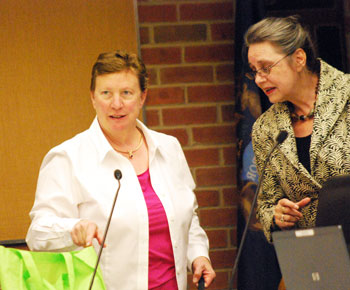
From left: Councilmembers Sandi Smith (Ward 1) and Sabra Briere (Ward 1). The two had co-sponsored a resolution establishing a task force to study the North Main Street and Huron River corridor. (Photos by the writer.)
In addition to the budget, the council efficiently dispatched with a fairly packed agenda of regular items, which are covered in this part of the meeting report. The item generating the most discussion was a follow-up to action taken at the council’s previous meeting on May 7, to establish a task force to study the North Main Street and Huron River corridor.
That resolution had provided for nine task force members representing different constituencies. At the May 21 meeting, a resolution was brought forward to add three members. A debate unfolded about whether to add a fourth member – from the Ann Arbor public art commission – to the mix. Ultimately that addition was approved narrowly on a 6-5 vote on the 11-member council.
While the North Main task force is meant to develop a vision for future land use in the corridor, the council took action on several current land use items too. Winning easy approval were a site plan for Allen Creek Preschool on Miller Avenue, and a rezoning and site plan for Michigan AAA on South Main Street. The council also quickly approved six routine rezoning requests associated with annexation from a township into the city of Ann Arbor. And councilmembers gave initial approval to revisions of the planned unit development regulations for a Shell service station on Ann Arbor-Saline and West Eisenhower Parkway.
Associated with these land use items were a total of 10 separate public hearings. However, no one addressed the council during any of those hearings.
The city’s park system made it onto the agenda in a few different ways. First, a consent agenda item was pulled out for separate consideration to highlight the fact that renovations to South University Park were being funded with a $50,000 gift that had been made by a couple – Leslie and Michael Morris – who previously lived next to the park. The council also approved the lease of a 40-space parking lot near Argo Canoe liveries to meet additional demand for river trips that has been generated by construction of the Argo Cascades bypass around the dam.
Related to open space outside the city were the reappointments of two members of the greenbelt advisory commission – Peter Allen and Catherine Riseng. The commission overseas a portion of the city’s open space and parkland preservation millage.
Financial issues considered by the council included initial approval to increase water, sewer and stormwater rates that will together generate an additional $1.7 million in annual revenue. The council also approved a tax abatement for Sakti3, a battery technology company in Ann Arbor that is looking to expand its operation here.
Other items on the agenda included receipt of a federal grant to develop a strategy for improved energy efficiency in rental housing, as well as a grant administered for laptop computers to be used as electronic pollbooks. The computers are used for election record-keeping, not for casting ballots. The council also gave initial approval to an ordinance revision that relieves homeowners of responsibility for maintaining sidewalks adjacent to their property for the duration of the sidewalk-repair millage, which voters approved in November 2011. [Full Story]
Art for E. Stadium, Argo Cascades Moves Ahead
Ann Arbor public art commission meeting (April 25, 2012): Two action items on this month’s AAPAC agenda advanced art projects to be located at the East Stadium bridges and Argo Cascades.
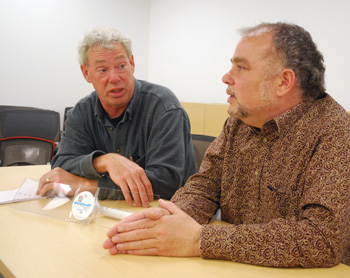
From left: Dave Konkle and Tim Jones spoke to the Ann Arbor public art commission about their Whirlydoodle project. Jones invented the device, which is on the table between them and is designed to highlight wind energy. Many others are already installed on light poles and elsewhere throughout downtown Ann Arbor. (Photos by the writer.)
Commissioners approved a $150,000 budget for artwork at the new Huron River bypass near the Argo Pond canoe livery – called Argo Cascades. A task force recommended that the artwork have a “water” theme, and use the bulk of $155,561 that has accumulated from the city’s Percent for Art funds from water-related capital projects. The city will issue a request for artists to submit a statement of qualification (SOQ), and from those submittals a smaller number of artists will be paid $1,000 each to submit formal proposals.
In a separate vote, commissioners approved issuing a request for proposals (RFP) for artwork at the East Stadium bridges. They had previously set a budget of $400,000 for that project, which potentially will incorporate multiple locations on and near the reconstructed bridges.
Several other projects were discussed at the April 25 meeting, but no formal action was taken. During public commentary, commissioners heard from Dave Konkle and Tim Jones regarding a large Whirlydoodle installation they hope to build. The devices were invented by Jones as miniature wind generators, with LED lights that vary in color depending on wind speed – about two dozen are currently placed around the downtown area. A large-scale installation would help people to visualize wind currents and prompt a discussion about alternative energy, he said.
Konkle is the city’s former energy coordinator who now does consulting work for the Ann Arbor Downtown Development Authority as energy programs director. He told commissioners that a display of 1,000 Whirlydoodles – possible at the former landfill at Platt and Carpenter – would result in Ann Arbor having more wind generators than any other city in the world, and would bring the city national attention. The two men asked AAPAC to endorse the proposal, but commissioners did not act on it or discuss it in depth at the meeting.
They did discuss the status of a glass sculpture that AAPAC recommended for the lobby of the Justice Center, which awaits city council approval. At their April 2, 2012 meeting, councilmembers postponed a vote on the $150,000 project until their May 7 meeting, hoping to address concerns about access to the lobby. Visitors must pass through a security checkpoint to enter, and some councilmembers hope that the checkpoint can be relocated. AAPAC commissioners talked about the need to decouple the artwork approval from the broader concerns about access to the lobby, so that the art project can move forward.
During the meeting, two other potential projects were introduced: (1) an art loan program, to select work from individual artists or galleries that would be installed on city-owned property for a temporary period; and (2) a proposal to fund poles in the downtown area that would be used to hang banners over the street. Tony Derezinski, an AAPAC member who also serves on the city council, brought forward the idea for banner poles, to provide an alternative to the current anchors that are affixed to building facades. He described the poles as easels for the banners, which he characterized as artwork. The banners typically are purchased by organizations to promote upcoming events.
Commissioners also received updates on several ongoing projects at their April meeting: (1) the Golden Paintbrush awards, which will be presented in June; (2) a mural at Allmendinger Park; (3) artwork in the proposed city rain garden at Kingsley and First; and (4) signs for the city hall plaza and Herbert Dreiseitl water sculpture.
Commissioners also reached a consensus to hold another retreat in May, following up on a four-hour retreat on Feb. 26, 2012, to address the creation of a master plan for public art, among other issues. [Full Story]
Art Commission OKs Argo Cascades Project
A $150,000 budget for artwork at Argo Cascades was approved unanimously by the Ann Arbor public art commission at its April 25, 2012 meeting. The budget includes an artist contract of up to $115,000, as well as $35,000 to cover (1) a 10% contingency, (2) 10% for administration, and (3) honorariums for up to five artists at $1,000 each, to cover the cost of submitting proposals.
Argo Cascades is the new Huron River bypass near the Argo Pond canoe livery. A task force for the project recommended first issuing a statement of qualifications (SOQ), then narrowing down the candidates to a maximum of five artists who would submit more formal proposals. The task force identified four potential locations for art, including the bridges … [Full Story]
Long-Term Planning for Ann Arbor Public Art
Ann Arbor public art commission meeting (March 28, 2012): With four of the nine commissioners absent, AAPAC approved the budget for its next major project, allocating up to $400,000 for art tied to the East Stadium bridges reconstruction.

Rose White Park, adjacent to East Stadium Boulevard, is one location being considered for public art in a $400,000 budget approved by public art commissioners for the East Stadium bridges project. The blue tarp on the fence in the background serves to separate the park from the bridge construction. (Photos by the writer.)
A task force had recommended that the project be well-funded, because the location would be a highly visible landmark marking an entrance into the city – it’s near Michigan Stadium and the Crisler Center, for example. No artist has been selected yet, nor has a request for proposals been issued – that’s under review by the city attorney’s staff.
The artist would have a large role in selecting locations for the artwork. Places for art might include the underpass and staircases at South State Street; the fence along Rose White Park, which is adjacent to East Stadium Boulevard; or the bridges themselves, spanning over railroad tracks and South State Street. Any final project and budget would require the city council’s approval.
The commission postponed action on a proposal related to artwork at Argo Cascades, the new Huron River bypass near Argo Pond. Neither of the two commissioners who serve on a task force for the project – Malverne Winborne and John Kotarski – attended the AAPAC meeting, and other commissioners felt more information was needed before moving forward.
Final touches were put on an annual public art plan for FY 2013, describing projects that AAPAC intends to work on between July 1, 2012 and June 30, 2013. [.pdf of FY 2013 annual public art plan] In addition to specific art projects like those for the East Stadium bridges and a mural at Allmendinger Park, the two-page document calls for developing a master plan for public art to guide future decision-making through 2016.
During the meeting, Aaron Seagraves – the city’s public art administrator – noted that nominations are being accepted through April 13 for the Golden Paintbrush awards, which recognize local contributions to public art. A nomination form can be downloaded from the commission’s website.
The March 28 meeting was attended by three people who were not affiliated with the commission, including Jack Urban, a Kalamazoo County commissioner and chair of the Kalamazoo public arts commission. He noted that unlike Ann Arbor, the Kalamazoo public art commission does not have a funding source. So the group is looking to establish itself and seek financial support, he said. [Full Story]
Art Project at Argo Cascades Tabled
At its March 28, 2012 meeting, the Ann Arbor public art commission tabled action on a public art project at Argo Cascades, the new Huron River bypass near the Argo Pond canoe livery. Neither of the two commissioners who are on a task force for the project – Malverne Winborne and John Kotarski – attended the meeting, and other commissioners felt they needed more information before voting on a budget.
No specific location has been identified for the work. The task force recommended instead to issue a request for proposals (RFP) and get input on the location from the artist who’s eventually selected for this project. About $175,000 is available for the project from money that has accumulated in the city’s … [Full Story]




